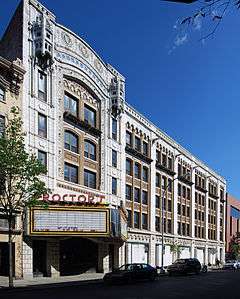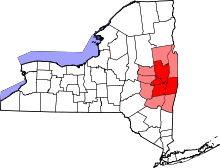Proctor's Theater (Troy, New York)
|
Proctor's Theater | |
|
Front (west) elevation, 2008 | |
| Location | Troy, NY |
|---|---|
| Coordinates | 42°43′50″N 73°41′20″W / 42.73056°N 73.68889°WCoordinates: 42°43′50″N 73°41′20″W / 42.73056°N 73.68889°W |
| Built | 1914[1] |
| Architect | Arland W. Johnson |
| Part of | Central Troy Historic District (#86001527) |
| MPS | Movie Palaces of the Tri-Cities TR |
| NRHP Reference # | 79001623 |
| Added to NRHP | 1979 |
Proctor's Theater is located on Fourth Street (northbound US 4) in Troy, New York, United States.[2] It was listed on the National Register of Historic Places in 1979, and is a contributing property to the Central Troy Historic District, added to the Register in 1986.
It was built in 1914 for vaudeville performances by Capital District entrepreneur Frederick Freeman Proctor, who also built another theater with his name in nearby Schenectady. Its double-balcony auditorium made it easily adaptable for showing motion pictures when that entertainment came into fashion soon after it opened. The building is credited to architect Arland W. Johnson.[3]
In the late 1970s it closed. Since then it has been through several owners, including Rensselaer Polytechnic Institute (RPI),[4] which have had various plans, including renovating it into office space or reusing it as a theater. In 2014, it was announced that Columbia Development would be renovating the building for the Rensselaer County Chamber of Commerce.[5]
Building
The theater is part of a row of buildings along the east side of Fourth Street. It is five stories high, with a highly decorative front facade of brick and marble covered in glazed terra-cotta. On the ground level, rusticated columns rise up to lion's heads. Five engaged marble columns frame the upper floors, rising to gargoyle-like figures, and two towers rise above the roofline at either end of the facade. The one above the main entry features a variety of terra cotta details: colonettes, dentils, escutcheons, and paretae.[1]
The interior has suffered from years of neglect, but its basic plan remains. The tiled lobby with arched ceilings and paneled walls, leads via staircases to the two balconies, and into a foyer to the orchestra floor. Gold leaf adorned (or originally did) the arches in that section. The proscenium features a David Lithgow painting of Lafayette's visit to Troy in 1824. All these fixtures remain unchanged from the theater's original construction.[1]
History
Proctor, who had already built and operated several successful vaudeville theaters in Albany and New York City hired Arlard Johnson to design the theater, hoping to make it his grandest project since he had entered the business nearly three decades before. It cost $325,000[6][7] to construct, and when it opened in 1914 it became the largest theater in the state and was praised as "a structure ranking foremost in American theatrical circles."[1]
From their inception, he had realized the potential of motion pictures and had begun adapting his theaters to the new medium. The Troy Proctor's classically inspired double-balcony form lent itself well to the movies because it put the audience close to the stage no matter where they were in the theater. It had not been designed to accommodate a projector and screen, but by the 1920s a booth had been added. During that era its productions, like many other theaters of the time, included both live and filmed entertainment. In the 1930s, with the advent of the sound era making the live act superfluous, the central chandelier was removed along with some other renovations, including removing the paintings from the lobby and painting over the gold leaf in the orchestra.[1]
After Proctor's death in 1929, the theater continued to operate as a popular downtown destination. After the mid-20th century, it began to lose business due to television and suburbanization. In 1977, it finally closed, its last show seen by a crowd of around 40 people. A year later the city acquired the property when it foreclosed on the then-owners. It is the only remaining movie palace in Troy, albeit unused for that purpose ever since then.
Redevelopment proposal
In the early 2000s, RPI acquired the building and hoped to partially use it as office space and keep the theater. They eventually brought in a developer who proposed to use a state grant to gut the building's interior and replace the auditorium with office space, while keeping the facade. Residents organized a group and online petition in opposition to this, pointing to how successful the restoration of the Schenectady Proctor's had been for that city. The building was structurally sound, and could easily be restored to its original purpose.[8]
Proponents of the plan responded that the theater had not been successfully redeveloped in the years since it had closed and it was time to try something else to revitalize a block of downtown Troy that remained dilapidated. They noted that the Schenectady Proctor's still lost money and that the project would create jobs the city needed in a slow economy.[8][9]
Restore NY grant
As of March, 2011, the theatre is expected to receive $3.3 million from a "Restore NY" grant. The money would be used by Columbia Development to rehabilitate the theatre building and two adjacent office buildings, including the Chasan Building, which is also owned by RPI.[10]
In October 2011 it was announced that, in a $14.4 million public-private project including a $3.3 million Restore New York grant, Columbia Development Companies would acquire Proctor’s Theater and launch a restoration.[11]
See also
Notes and references
- 1 2 3 4 5 Powers, Robert (May 1979). "National Register of Historic Places nomination, Proctor's Theater". New York State Office of Parks, Recreation and Historic Preservation. Retrieved 2008-10-28.
- ↑ Architecture and Building, Volume 47 W.T. Comstock Company, 1915
- ↑
- ↑ "Rensselaer Announces Purchase of Proctor's Theatre Building in Downtown Troy" (Press release). Rensselaer Polytechnic Institute. 2004-04-06. Retrieved 2008-10-28.
The goal is to develop a high-end hotel that will provide economic and community benefits to the city of Troy and to the surrounding area
- ↑
- ↑ $7.69 million in contemporary dollars
- ↑ Federal Reserve Bank of Minneapolis Community Development Project. "Consumer Price Index (estimate) 1800–". Federal Reserve Bank of Minneapolis. Retrieved October 21, 2016.
- 1 2 Caprood, Tom (April 23, 2009). "A discussion about Proctor's". The Record. Journal Register Company. Retrieved June 11, 2009.
- ↑ Young, Elizabeth (April 8, 2009). "The Drama Over Troy's Theatre". Albany Times-Union. Hearst Corporation. Retrieved June 10, 2009.
32 years is a long time. 32 years vacant. 32 years of a block of Downtown Troy that I would not walk down alone after dark. 32 years of similar preservation efforts that have blossomed, and then withered. 32 years of potential, left unfulfilled. I am 31 years old - this building has been vacant for my entire lifetime.
- ↑ "Troy Proctor's in line for $3.3M in state funding". The Times Union. 24 March 2011. Retrieved 24 March 2011.
- ↑ Rensselaer Polytechnic Institute (October 24, 2011). "Columbia Development Companies To Acquire Proctor's Theater and Chasan Building in Troy and Launch Restoration". Retrieved October 25, 2011.
External links
- Save Proctor's Theater!, site for opponents of redevelopment
- Recent photographs of Proctor's Theatre



